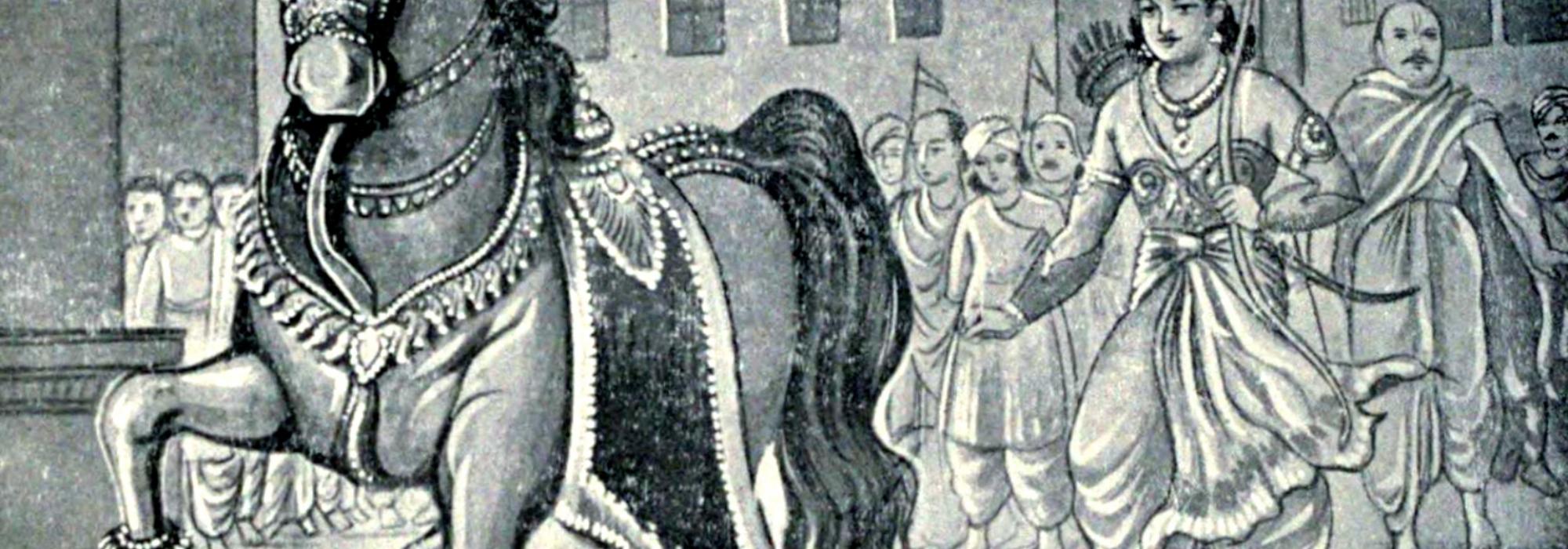In the Yajurveda, we see manifestly the greatness accorded to the essence of kshaatra. An important representative of the essence of kshaatra is the ashvamedha yajna. The Taittiriya Samhita says ‘यजुर्वेदं क्षत्रियस्याहुर्योनिम्’ (3.12.1.2) suggesting that the Yajurveda is the origin of the kshatriyas. In our Vedas, the ऋक् has been associated with brahmanas, यजुस् with kshatriyas, and सामन् with vaishyas [there are other views too; for example, Taittiriya Brahmana 3.12.9.2 says that brahman created the three varnas from the three Vedas – vaishyas from Rigveda, kshatriyas from Yajurveda, and brahmanas from Samaveda.) The Yajurveda has been called an action-oriented, ritual-intensive Veda; Rigveda is more aligned to prayer, Samaveda is aligned to worship, and Atharva Veda forms a bridge between the physical and the spiritual.
[contextly_sidebar id="Pzh29FafvvcxxZSKTlyfic1LHW4u2cks"]
Yajurveda is a symbol of kshaatra, of protection, and of destruction of enemies. The Upaveda associated with Yajurveda is Arthaveda (or Dhanurveda). Mahidasa Pandita says “धनुर्वेदो युद्धशास्त्रम्” while giving an explanation. Through the Dhanurveda we see the entire system of war. The yajnas like राजसूय, सौत्रामणी, वाजपेय, and अश्वमेध that are described in the Yajurveda are famous as kshaatra-yajnas. The vajapeya yajna is for preparing various factions of the army in order to reclaim lost land. The sautramani yajna is for bringing allies together. The rajasuya yajna is conducted when an emperor is born or created (‘राजसूय’ literally means ‘rises up to the level’) [This is different from राज-पट्टाभिषेक, ‘coronation of the king when he ascends the throne.’] The ashvamedha yajna is for expanding the kingdom and establishing sovereign status over a large portion of land. We see unbridled kshaatra in all these yajnas.
There are elements of kshaatra even in our traditional practices related to worship and invoking the Supreme. The unfortunate situation today is that worship has entered military science. We have induced a narrow, ritualistic mindset in our military thus reducing bravery and energy. However, our Vedic seers brought an element of kshaatra in worship and ritual – this much is clear. Shukla Yajurveda, which is a branch of the Yajurveda, has a verse that says, “यत्र ब्रह्म च क्षत्रं च सम्यञ्चौ चरतः सह| तं लोकं पुण्यं प्रज्ञेषं यत्र देवा सहाग्निना||” (SYV 20.25) – Only when kshaatra and braahma come together the deities give punya; this is “prajnesam,” i.e. 'it is my understanding,' says Yajnavalkya. There is another verse which says,
“बाहो मे बलम् इन्द्रियं हस्तौ मे कर्मवीर्यम्| आत्मा क्षत्रमूरो मम”
(SYV 20.7)
There is strength in my shoulders, so also in my senses; there is karma in my arms, so also in my courage – one hand to do their work and the other to exhibit bravery; my Self itself is kshaatra.
Thus we realize how important kshaatra is for the world. Just because one is endowed with kshaatra doesn’t imply that one has to cause injury or harm to others. The spirit of kshaatra is not to glorify violence; on the contrary, it arose in order to destroy violence. The Rigveda hails Indra as one who lives with courage that befits a hero.
Even in the रुद्राध्यय, various names and titles of Rudra (an important deity of the Rigveda) are associated with kshaatra. In those verses, Rudra is hailed as the greatest of kshatriyas. Rudra is the deity who presides over the various weapons of war. Just like light is said to originate from the twelve adityas, valor originates from the eleven rudras. The forty-seven maruts are also associated with Rudra and have the same spirit of kshaatra. After saying, “नमस्सेनाभ्यः सेनापतिभ्यश्च नमो नमः,” Rudra has been described as ‘one who drives chariots, when chariot-less one who mounts elephants and horses, one who can wield a hundred bows at once and fight a battle, one who rapidly destroys the enemies, one who drives the chariot as swiftly as an arrow – he is mahadeva!” He is hailed as one who is well-versed with all aspects of warfare, one who shows the world the courage of his army, one who destroys his opponents the instant he sees them, and one who can destroy his enemies even if they are far away. From this we know how much of value our ancients laid on kshaatra. In the Atharva Veda, there is an invocation prayer that says,
The great seers who knew both heaven and wellness, for the sake of auspiciousness in the world, gave diksa. Only then did the nation arise. Strength and vigor came to it. By the result of the tapas and foresight of seers, may the deities give vigor to this nation. And may such a nation be ruled by a king who adheres to the principles of brahmacarya and tapas.
Translated from Kannada by Hari Ravikumar
(Translator’s notes in square brackets.)








































